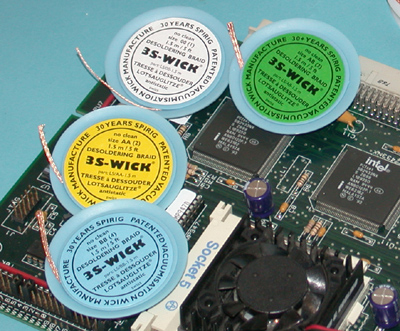Spirig Desolder braid
Product Description
3S-Wick® - ROHS conform -
- RoHS Directive 2002/95/EC approved by SGS Germany
- No-clean flux meets DIN EN 29 454 1.1.3
3S-Wick® - REACH -
The REACH registration of the chemicals used in the Desoldering Braids impregnation will be handled by Spirig Company and is in the Preregistration stage.
The product Desoldering Braid from Spirig will continue to be available in the EU markets.
More relevant informations, click here.
Learning on REACH? Click here.
3S-Wick® patented vacuumization technology is preferred by leading organizations worldwide. Vacuumization yields a high-speed response wick for quickest and safest de-soldering. A simultaneaous comparison dip-test (MIL-STD-202 E Method 208 C) with competitive wicks will show the differences.
3S-Wick® flux is based on mildest non-corrosive, non-hygroscopic, non-conductive rosins of 'no-clean' quality.
3S-Wick® conforms to the most stringent soldering standards set worldwide i.e. DIN-8516, DIN-8527, DIN-8511-F-SW32 (German), BS-441, DTD-599A (British), JIS-C-2519, JIS-C-2512 (Japanese), ASTM-B284, NASA Publications MIL-F-14256D type W and A, NPC-200-4 Quality Publication, NASA-SP5002 Soldering Electrical Connections, NASA-NHB-5300 Reliability and Quality Assurance Publications, and others.
3S-Wick® is used and has been used for the most demanding desoldering operations in spacecraft and military electronics. 'No-clean' residues can be left safely on the desoldered area.
IMPORTANT:
The minimal residues left on the soldered area do also act as asolderability conservation for that area, should the resoldering not be done immediately there.
The technical term 'no-clean' Wick found in desolder braid descriptions and specs usually refers to a wick whose desoldering operation only leaves a minor amount of flux on the desoldered area and which do use a flux composition whose residues can be left safely on the desoldered area.
A fluxless wick as often proposed does not exist and can not function by metallurgical reasons.
LOTSAUGLITZE® is a German word created about 36 years ago by Spirig and is registered as a trademark for Spirig. The commercial wicking technology to remove solder was established in Europe by Spirig.
Entlötlitze is also a recently created German word expression for desoldering braid and the use of Entlötlitze is free for the public use to describe this desoldering technology/products.
Advantages
Why is it advantageous to remove solder using 3S-Wick®?
Wicking avoids damaging and life reducing heat shocks to components, printed circuit boards copper tracks (peel off danger if overheated) and surrounding components. Wicking also protects these parts against excessive temperatures of idling mechanical solder suckers.
3S-Wick® is made from high heat conductive copper and presents sufficient thermal mass per length to dampen heat shocks. Compare this to competing low thermal mass wicks!
The cold 3S-Wick® end is pressed with the hot soldering iron tip on solder to be absorbed. The cold wick and cold solder increase now gradually in temperature. There is no sudden temperature increase with large temperature gradients causing exteme thermal stress to the solder area. As wick and solder reach the melting temperature range of the solder, the solder liquefies and is almost instantaneously drawn by capillary forces into the wick, like ink into a blotter. Wick and tip should now be lifted simultaneously. The wick end with the absorbed solder is now cut off preparing a fresh wick end for the next de-solder operation.
3S-Wick® is made from high heat conductive copper with sufficient thermal mass and protects therefore against those "deadly" hot idling iron tip temperatures. The thermal mass of 3S-Wick® naturally cools the solder tip.
A too small solder tip compared to the 3S-Wick® size causes the tip temperature to considerably drop. The resulting temperature of the wick end, solder and tip might even fall under the melting point of the solder. Such a situation will not give a satisfactory desoldering operation.
If the temperature drops below the melting temperature then the temperature will rise only slowly by the heating power of the iron. The desoldering operates slowly, looks like freezing.
The size of tip therefore should be large enough to be able to store sufficient heat energy in its mass to bring upon contact the temperature of the wick and solder safely above the melting point of the solder. Correct wicking uses the stored heat in the tip for a speedy desoldering operation.
De-soldering by wicking means actually soldering the wick with the unwanted (to be removed) solder. The solderability of the wick is therefore a direct quality indicator for the wick itself.




